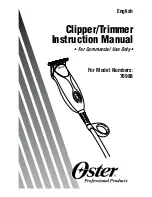
11.
MACHINE OPERATION
The chipper is a flywheel and knife type of as they are fed into the head. The blades must be sharp to operate
properly. Dirt, rocks, nails, or other foreign material will shorten blade life.
Before operating the chipper review the machine checklist. After turning the chipper by hand and making sure
there no obstructions in the head, start the tractor and raise the chipper until the PTO shaft is within 15
degrees of straight.
Start the chipper slowly with the PTO engaged, and release the PTO clutch slowly. Gradually increase speed
until the tractor PTO speed is 540 RPM.
The material will feed into the head more easily if your start the pieces with the large end first .
The feed roll will fold branches as they are pulled into the hopper. Occasionally, a limo fork may have to be cut
to feed properly.
If the material stops feeding, sometimes a little push on the long end of the limo will help.
If the material stops the feed roll, release the feed roll clutch by pushing it toward the chute. Hold the clutch
in the disengaged mode, and pull the material out the hopper. Release the feed roll clutch and the feed roll
will turn again.
Remember to cut only clean material, or blade life will be shortened.
Do not move the unit while the flywheel is turning.
Block the wheels and set the brake while running the head.
Watch the discharge chute while operating the unit and if the chips stop flowing
stop feeding material
into the unit by moving the feed roll clutch handle toward the chute and pulling the material from the hopper.
Most of the time this will be enough to clear the chips out of the unit. If the unit slows down noticeably, first
shut off the PTO power, then the tractor.
Unplug the head by turning it backwards by hand with the discharge chute and top section of the wrapper off.
Remove the chips from the top of the head. If this fails, remove the clean-out door, located on the lower part
of the front side-plate of the chipper below the main shaft. Then worked the chips out the case.
Replace the clean-out door after all the chips are removed, being sure to use both the lock washers and flat
washers.
Turn the head by hand after assembly to be sure it turns freely. Be sure to replace the chip deflector.
Do not operate the unit without the deflector in place.
Before stopping the chipper, be sure that all of the material is out the head and out of the feed roll.
All of the material in the chute must be gone or the unit could jam on a small piece of material. This can usually
be cleared by tuning the unit backwards by hand.
To replace the blades, take the PTO shaft out of gear. Shut off the tractor and keep the keys in your pocket.
The blades on most models are replaced or turned by removing the inspection plate on the side opposite the
chute.
Unhook the feed roll springs, block the feed roll to maximum position, and, with an allen wrench on the chute
side and a socket on the other, remove the bolts.
Be careful not drop any parts inside.
Remove the blade, clean the blade pocket, and turn or sharpen the blade. Replace.
Torque the bolts to 50 foot-pounds in all holes so the bolts are straight through the flywheel.
A small screwdriver or ice pick works well to clean pockets for the allen wrench.


































